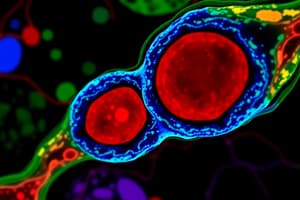Podcast
Questions and Answers
What is the level of organization referred to as tissue?
What is the level of organization referred to as tissue?
- Organized layers of different types of cells (correct)
- Structured arrangement of cells within an organism
- Random distribution of different cell types throughout the body
- High degree of organization among cells in a specific organ
How many distinct cell types are mentioned to be present in the body?
How many distinct cell types are mentioned to be present in the body?
- At least 200 (correct)
- Around 300
- Exactly 100
- More than 500
What does the micrograph in the chapter show?
What does the micrograph in the chapter show?
- Normal tissue without any irregularities
- Irregular architecture of normal tissue contrasted with regular arrangement of cancerous cells
- Abnormal tissue without any regular features
- Regular architecture of normal tissue contrasted with irregular arrangement of cancerous cells (correct)
How do the different types of cells vary in shape and function?
How do the different types of cells vary in shape and function?
What enables the functions of various epithelial tissues?
What enables the functions of various epithelial tissues?
How are the characteristics of nervous tissue described?
How are the characteristics of nervous tissue described?
What is the major function of connective tissue?
What is the major function of connective tissue?
Which type of cells are present in all connective tissue proper?
Which type of cells are present in all connective tissue proper?
What is the main characteristic of loose connective tissue?
What is the main characteristic of loose connective tissue?
Which type of adipocytes store lipids as many droplets and have high metabolic activity?
Which type of adipocytes store lipids as many droplets and have high metabolic activity?
What do macrophages do in the connective tissue?
What do macrophages do in the connective tissue?
What is the characteristic component of the matrix in connective tissues?
What is the characteristic component of the matrix in connective tissues?
What is the function of cilia in epithelial cells?
What is the function of cilia in epithelial cells?
What is the main function of microvilli in epithelial cells?
What is the main function of microvilli in epithelial cells?
Which type of cell junction separates cells into apical and basal compartments?
Which type of cell junction separates cells into apical and basal compartments?
Where is simple squamous epithelium typically found?
Where is simple squamous epithelium typically found?
What is the main function of complex epithelial tissues?
What is the main function of complex epithelial tissues?
What characterizes stratified epithelia?
What characterizes stratified epithelia?
Which type of tissue is nearly completely avascular?
Which type of tissue is nearly completely avascular?
What type of tissue provides the body's first line of protection and controls permeability?
What type of tissue provides the body's first line of protection and controls permeability?
Which type of tissue contracts to provide movement?
Which type of tissue contracts to provide movement?
What type of tissue transmits electrochemical signals between different regions of the body?
What type of tissue transmits electrochemical signals between different regions of the body?
Which type of tissue binds cells and organs together, providing support and protection?
Which type of tissue binds cells and organs together, providing support and protection?
Which type of tissue is highly cellular and has specialized intercellular connections called cell junctions?
Which type of tissue is highly cellular and has specialized intercellular connections called cell junctions?
Where would one find ciliated columnar epithelium?
Where would one find ciliated columnar epithelium?
What is the function of pseudostratified columnar epithelium?
What is the function of pseudostratified columnar epithelium?
Which type of epithelium appears to be stratified but consists of a single layer of irregularly shaped and differently sized columnar cells?
Which type of epithelium appears to be stratified but consists of a single layer of irregularly shaped and differently sized columnar cells?
Where is non-keratinizing stratified squamous epithelium found in the body?
Where is non-keratinizing stratified squamous epithelium found in the body?
What is the function of endocrine glands?
What is the function of endocrine glands?
What characterizes exocrine glands?
What characterizes exocrine glands?
Flashcards are hidden until you start studying
Study Notes
- The human body is made up of trillions of cells, organized into tissues and organs.
- There are four main types of tissues: epithelial, connective, muscle, and nervous.
- Epithelial tissue is a sheet-like tissue that covers external and internal surfaces and forms certain glands.
- Epithelium lines the skin, airways, digestive tract, urinary and reproductive systems, and internal cavities.
- Epithelial tissue is highly cellular and adjoining cells have specialized intercellular connections called cell junctions.
- Epithelium is nearly completely avascular, relying on diffusion or absorption for nutrients.
- Epithelial tissue provides the body's first line of protection and controls permeability.
- Epithelial cells are polarized, meaning they have different structures and functions on their apical and basal surfaces.
- Epithelial tissue can rapidly replace damaged cells and some cells secrete mucous or chemicals onto their apical surfaces.
- Endothelium, a type of epithelium, lines the interior surfaces of blood vessels and body cavities.
- Connective tissue binds cells and organs together, providing support and protection.
- Muscle tissue contracts to provide movement.
- Nervous tissue transmits electrochemical signals between different regions of the body.
- Organs are made up of several types of tissues working together to perform specific functions.
- Epithelial and connective tissues are discussed in detail in the text, while muscle and nervous tissues are briefly mentioned.
Studying That Suits You
Use AI to generate personalized quizzes and flashcards to suit your learning preferences.



